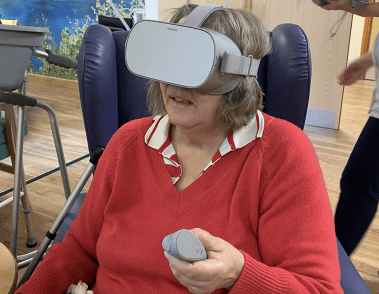
How would you like to fly like a bird? Visit outer space? Dive under water and swim with the fish in exotic places? Thanks to virtual reality (VR) technology you can now do just that – and patients at Rowley Regis Hospital’s Heart of Sandwell Day Hospice are getting to experience it.
As part of the team’s efforts to help patients achieve their day hospice goals, they have acquired two standalone Oculus Go headsets to help patients ‘leave’ the confines of the hospice, travel to faraway places and discover new things. The headset is also used for relaxation sessions, utilising both VR programs and 360-degree video experiences to help manage any anxiety or sleep problems they had been having. It has also helped conquer some very long standing fears, as one member of the hospice revealed.
“It’s wonderful,” explained patient Daphne Barnes. “I’ve always been terrified of water from when I was about five or six-years-old, but when I was using the VR I had no fear. Even though it seemed to cover me I could still get my head above the water, I could see the fish swimming in the water around me, I could see the coral, I could see the islands and the sky. It was so lovely – I just can’t find the words to describe it.”
Daphne’s experience came after trying VR experience ‘David Attenborough’s Great Barrier Reef Dive’, which sees the 92-year-old broadcaster examine life found in the natural wonder off the coast of Queensland, Australia. Other experiences on the hospice headsets at this time include encounters with dinosaurs, trips down nature trails and visits to far flung locations around the world.
Claire Roach, an Occupational Therapist working with the hospice said: “We’ve decided to use virtual reality to help our patients with advanced care planning and also to improve their quality of life and general wellbeing. So, we’re looking at issues such as managing anxiety and helping them achieve long held goals – say, if they wanted to go to a specific country or experience something they’d otherwise be unable to. With VR that closed door is opened for them again.”
With this recent new generation of immersive technology being powered by the HTC, Sony, Google and Facebook owned Oculus – which donated the first of the hospice’s headsets – using VR as a treatment has become an idea health authorities and MedTech firms around the world are continuing to investigate. With everything from education and training for practitioners, to pain management and helping deal with psychological disorders for patients being looked into.
Claire Roach thinks that as the technology continues to develop, further investment in VR by the Trust could be a possibility; especially considering what it can do even now. She added: “Areas such as pain management, or using it to help relax patients who are distressed, helping treat phobias and trauma, that’s just the tip of the iceberg. I see the future of VR in healthcare as something that is very important and I think there’s scope for a lot of development there.”
For now it is something the members of the hospice can enjoy and talk about – even encouraging staff and visitors to give the new technology a try. Daphne even says her experience means she’s got something more she can discuss with her grandson who uses VR to play videogames. However, as keen as she is to take in more trips beyond the hospice walls it’s what it has done for her outside of entertainment that she is most in awe of.
She summed up: “I would recommend it to anyone. It’s taken away my fear, and I’ve been afraid of that for a very long time.”


No Comments
Leave a Comment